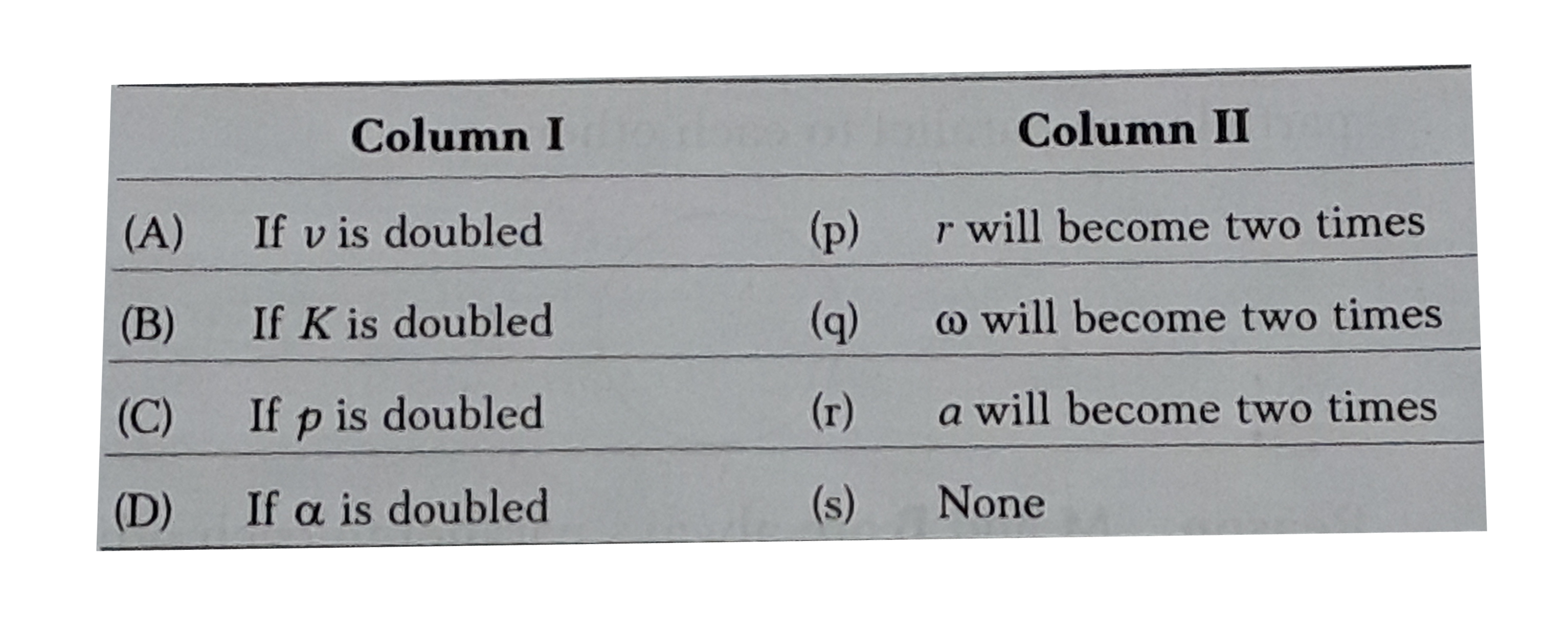In a non - uniform circular motaion the ratio of tangential to radial acceleration is (where, r= radius of circle, v= speed of the particle, α= angular acceleration)
α2r2u
α2ru2
αr2u2
u2r2α
The correct Answer is:C
To solve the problem of finding the ratio of tangential to radial acceleration in non-uniform circular motion, we will follow these steps:
Step 1: Understand the Definitions
In non-uniform circular motion, a particle experiences two types of acceleration:
- Tangential Acceleration (A_t): This is due to the change in the speed of the particle along the circular path. It is given by the formula:
At=r⋅α
where r is the radius of the circular path and α is the angular acceleration.
- Radial (Centripetal) Acceleration (A_r): This is due to the change in direction of the velocity vector as the particle moves along the circular path. It is given by the formula:
Ar=v2r
where v is the linear speed of the particle.
Step 2: Write the Ratio
We want to find the ratio of tangential acceleration to radial acceleration:
Ratio=AtAr
Step 3: Substitute the Formulas
Substituting the expressions for At and Ar into the ratio gives:
Ratio=r⋅αv2r
Step 4: Simplify the Expression
Now, simplify the ratio:
Ratio=r⋅α⋅rv2=r2⋅αv2
Step 5: Final Result
Thus, the final expression for the ratio of tangential to radial acceleration is:
AtAr=r2⋅αv2
Conclusion
The ratio of tangential to radial acceleration in non-uniform circular motion is given by:
AtAr=r2⋅αv2
---
In non-uniform circular motion, a particle experiences two types of acceleration:
- Tangential Acceleration (A_t): This is due to the change in the speed of the particle along the circular path. It is given by the formula:
At=r⋅α
where r is the radius of the circular path and α is the angular acceleration.
Ar=v2r
where v is the linear speed of the particle.
We want to find the ratio of tangential acceleration to radial acceleration:
Ratio=AtAr
Substituting the expressions for At and Ar into the ratio gives:
Ratio=r⋅αv2r
Now, simplify the ratio:
Ratio=r⋅α⋅rv2=r2⋅αv2
Thus, the final expression for the ratio of tangential to radial acceleration is:
AtAr=r2⋅αv2
The ratio of tangential to radial acceleration in non-uniform circular motion is given by:
AtAr=r2⋅αv2
Similar Questions
In a non-uniform circular motion, what is the direction of acceleration ? Discuss.
View SolutionA charged particle is rotating in uniform circular motion in a uniform magnetic field . Let r= radius of circule, v= speed of particle k = kinetic energy, a= magnitude of acceleration , p= magnitude of linear momentum, qm=α=specific charge and ω= angular speed. then match the following two columns.

View SolutionFor a particle in uniform circular motion the acceleration a at a point P(R,θ) on the circle of radius R is (here 'v' is the speed of the particle and θ is measured from the x-axis)
View SolutionAssertion:- A particle is moving in a circle with constant tangential acceleration such that its speed v is increasing. Angle made by resultant acceleration of the particle with tangential acceleration increases with time.
Reason:- Tangential acceleration =∣∣∣d→vdt∣∣∣ and centripetal acceleration =v2R
View SolutionIn a circular motion of a particle the tangential acceleration of the particle is given by a1=2m/s2. The radius of the circle described is 4 m. The particle is initially at rest. Time after which total acceleration of the particle makes 45∘ with radial acceleration is :
View SolutionIn a circular motion of a particle , the tangential acceleration of the particle is given by at=9ms−2 . The radius of the circle is 4m . The particle was initially at rest. Time after which total acceleration of the particle makes an angle of 45∘ with the radial acceleration is
View SolutionIn the following questions a statement of assertion (A) is followed by a statement of reason ( R).
A : A uniform circular motion have non uniform acceleration .
R: The direction of acceleration of a particle in uniform circular motion changes continuously .
View SolutionSTATEMENT -1 : In non - uniform circular motion acceleration of a particles is along the tangent of the circle .
STATEMENT -2 : In uniform circular motion acceleration of a particle is zero .
STATEMENT -3 : In no - uniform circular motion acceleration of a particle is towards the centre of the circle.
View SolutionA particle is projected at t=0 with velocity u at angle θ with the horizontal. Then the ratio of the tangential acceleration and the radius of curvature at the point of projection is :
View SolutionA particle is moving on a circle of radius R such that at every instant the tangential and radial accelerations are equal in magnitude. If the velocity of the particle be v0 at t=0, the time for the completion of the half of the first revolution will be
View Solution